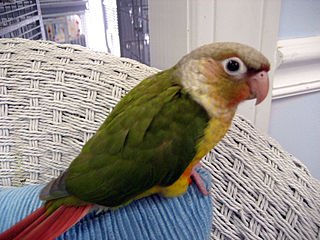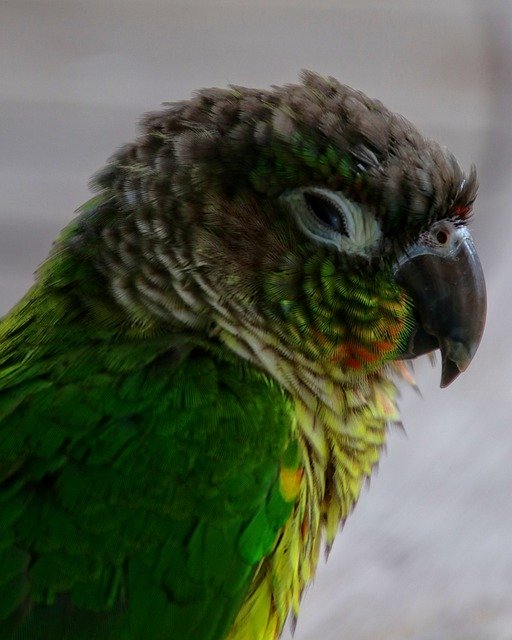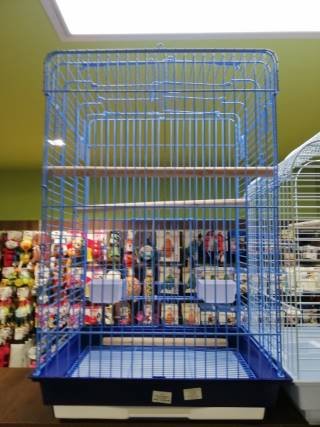Green Cheek Conures, as one of the most common parrot species worldwide, make excellent pets for their affectionate nature and stunning look. Moreover, they come in a wide variety of colors. Unique looks are the result of color gene mutations. For big personality or rich genetics, Green Conures are favored by both bird lovers and ornithologists for a reason.
Terms explanation: Mutation, what is it?
You have probably seen this term when searching for a parrot. In case you are not exactly sure what it is, we will explain it. Mutation originates from the scientific vocabulary. Specifically, it is tied to genetics, a scientific field studying inheritance. More precisely, their studies are mostly concentrated on genes, the carriers of information in reproduction.
Other terms you may have come across are dominant and recessive mutations. Genes do come in two variations. Imagine it as a big and small one. On the type, whether it is a dominant or recessive gene that is responsible for certain characteristics, depends what trait the species is going to display.
Genes are placed on chromosomes. Each species has a limited number of them. Most of the chromosomes are autosomal (affect most of the body functions), and there is a pair of sex chromosomes that control the reproduction and define gender. When a mutation is sex-linked, it means that genes affected by the mutation are located on sex chromosomes, and depending on the gender, they express differently.
More often than not people mistake mutations with hybridization. As genetics and technology are rapidly improving, scientists are evolving in hybridization with all the species. That’s a process where, in jargon, they ‘’mix’’ different species to improve them. We are not going to be talking about it. Mutations we mention are color mutations and can happen naturally when breeding parrots of the same species but with different color variants.
Now that we are familiar with the vocabulary, let’s see what does Turquoise mutation looks like.
How does Torquoise mutation happen?
Turquoise is a recessive mutation that results in reduced expression of psittacine pigment. This pigment is responsible for the yellow and red colors. As a result, Turquoise has less of these colors compared to their original relative, Green Cheek Conure.
How much is Turquoise Green Cheek Conure?
Turquoise GCC is selling for 300$ to 600$. The price for Turquoise Conure at Finch Farm is $579.99.
https://thefinchfarm.com/turquoise-green-cheeked-conure/
This bird looks quite similar to the standard Green Cheek Conure. The main difference is that where Green Cheek is green, Turquoise is, well, turquoise, or bluish-green.
Turquoise Conure Habitat and Lifespan
This unique parrot family inhabits forests and woodlands of Paraguay, Brazil, Argentina, and Bolivia. Humidity, temperature, and moisture they are used to is quite harsh. This is one of the reasons that keep them alive and abundant. Many parrot species suffer from habitat destruction and are increasingly becoming endangered. Green Cheeks are highly adaptable. If you provide them with proper care, they can happily live for over 25 years.
Turquoise Conure Size
Green Cheek Conures are the smallest in the family. Only 10 inches long they can fit in most of the households.
Turquoise Green Cheek Conures as pets
Green Cheek Conures are a popular option for pets in that they are suitable for owners of any experience level. Taming and training are not particularly challenging because of their good nature. Still, professionals enjoy them for sweet character and beauty. Not many parrots are given the apartment-friendly title. Green Cheek Conures deserve it due to the compact size, adaptability, and voicing habits.
Turquoise Green Cheek Conure Personality and Behavior
When it comes to caretaking, they are not particularly demanding. However, they have specific emotional needs, which reflect on their physical health.
Bonding is a feature they are known for. Green Cheek Conures easily make strong ties with the family members. They love them and try to attract the owners whenever possible. They make great pets in that they connect with the whole family. Bonding is specifically intense with children. Just, when they interact, you may want to keep an eye on biting.
Green Cheeks are known by the nickname ‘’little clowns’’. Full of spirit, they like to hang upside down to seek attention. It is hard not to laugh when around them. They highly appreciate the time spent out of the cage. Curiosity and playfulness, along with extra energy they hold, needs to be expressed regularly.
They are very affectionate birds. They like to cuddle and to be petted. Generally, they need to be showered with attention. This aspect is crucial to consider before getting your Green Cheek. The initial excitement of having a pet fades after some time. But, on their energy level, no change happens over time. When they get used to you being around and playing all the time, in the beginning, they would always expect it. When denied that promised attention, they would suffer. So, decide early on what level of affection you can dedicate them constantly. When Conures are happy and well adjusted, they can entertain themselves when you are not home.
If you don’t have as much time for the concentrated dedication, light volume entertainment solution can be provided with a proper cage position. Make sure to place it where most of the household traffic happens. For instance, see if you can find room in the area where the family gathers.
Get them used to change- It seems like most of the living organisms need to create this habit. When we get into the monotony of the day to day life, all the changes are difficult to accept. Even for humans, as rational beings, changing the environment from time to time is necessary for healthy mental development. Bring in new people and toys frequently. Out of regular situations, for instance, traveling in care or nails trimming, would help them accept and enjoy change. Otherwise, they can become afraid of new toys or furniture for example.
Form habits and stick to them- Well, if you are struggling with creating and persisting in your habits, Green Cheek Conure companion would solve it for you. Most of the pets, relay on set routines. Parrots particularly need them. When they arrive at your home, set a plan, and perform it daily. That way birds would adjust to you and the new environment successfully. Transitions, when new members arrive in the family, are tough for humans too. You can both go through the acclimatization period easily if you keep the habits.
Do Turquoise Conure Talk?
Green Cheek Conures are quiet compared to other birds. It can make some noise, however. Their voicing is not as loud or frequent. When Green Cheek is well trained, primordial sounds can be reduced to the minimum.
Conure family is not famous for their talking abilities. Green Cheek Conures are not the exception. They are able to learn a couple of words but usually, but they don’t pride themselves in this skill. If the owner is persistent, vocabulary, and sounds they can reproduce could expend. Their voice is not clear, but you will be able to make up what they are saying.
There is so much in this bird to enjoy, that their speech would be completely out of the spotlight. Moreover, since they are not shy when they get to know you, ramblings would be rather comical.
Turquoise Conure Cage
Although small and lite, Green Cheek Conure requires spacious housing. As we have mentioned, they like to be free to move. The minimum size suitable is 25 x 21 x 29 inches, with ½ of an inch in wire spacing. If you wisely choose the size and position for a cage, living with a Conure could be way easier than usual.
Turquoise Conure Breeding
Reproduction is a challenging process for all of the pets. However, Green Cheek Conures are fairly Easy to breed. Per one clutch, hen typically lays 4 to 6 eggs. The incubation period lasts from 22 to 25 days, whereas 25 days is the most common. Both of the parents sit on eggs during the incubation period. They usually have three to four successful clutches a year.
More about Breeding Green Cheek Conures:
https://parrotquaker.com/breeding-green-cheek-conures/
Turquoise Conure Gender Difference
Turquoise Conure is a monomorphic species. This means that males and females are hard to tell apart. Some common methods would be watching for a hand shape, behavior, and feet color. Although sometimes correct, these criteria cannot be rallied on solely. Depending on the bird, characteristics can fool you. DNA testing is an only utterly reliable method. It may cost an additional 149 dollars.





